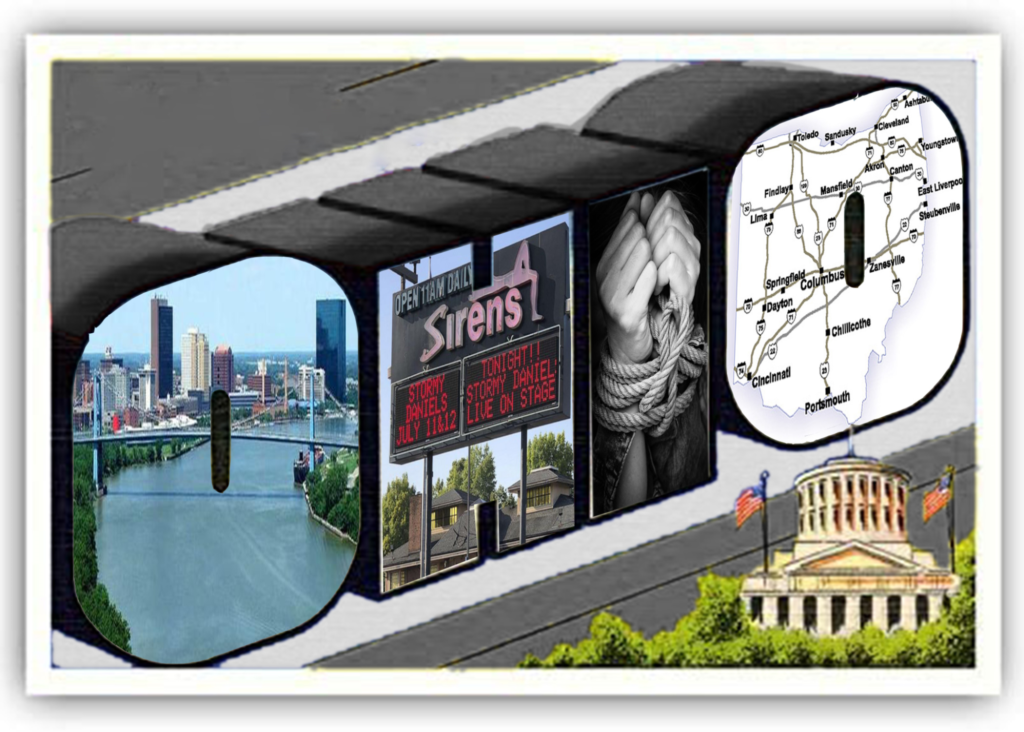I am a proud Ohioan. My dorm room is decked out in decorations from various Ohio sports teams. I have taken it upon myself to educate all my friends from the Northeast where Ohio is and what makes it great.
However, it has always troubled me that Ohio ranks fifth in human trafficking cases in the United States. The Victims of Trafficking and Violence Protection Act of 2000 (TVPA), defines human trafficking as “the use of force, fraud, or coercion to exploit another person through commercialized sex or involuntary labor.”

Why Ohio? The Role of Geography
Geography plays a significant role in the prevalence of sex trafficking in Ohio because of its central location within the United States, proximity to Canada, large bodies of water like Lake Erie and Ohio River, as well as its mix of rural and urban areas.
Ohio’s numerous interstate highways make transporting sex trafficking victims an easy task. The FBI named Toledo, OH, as the fourth worst city in the country in regards to human trafficking because of its expansive commercial sex market, which includes domestic and international trafficking victims.
Trafficking rings operate out of massage parlors, migrant camps, pornography studios, and strip clubs. Ohio has the fifth most strip clubs in the country. All of these places marginalize and frequently take advantage of these victims because of socioeconomic status and vulnerability.

As the map above shows, many major highways converge in the Toledo metropolitan area. Specifically, Toledo’s close proximity to Canada and Lake Erie makes it especially vulnerable to sex trafficking operations. Once a person becomes a victim of human trafficking, the traffickers often hide them in isolated areas where it becomes far easier to transport the victims across state and international borders. Ultimately, Ohio’s geography plays a key role in why it is a prominent market for human trafficking.
Who is at risk and why?
Between 2014-2016, in Ohio, there were 1,173 known victims. One victim was Kylee Gregg, who is a student at the University of Toledo. From the age of ten to fourteen she was a victim of human trafficking.
A local family took her in after they found out she was sleeping at a nearby park. They provided her with food, shelter, and school supplies. She was running away from her abusive and neglectful mother. As Gregg said, “they really treated me like family.” However, the family began asking for sexual favors for family members and eventually she was “taken to truck stops and motels and different people’s houses to be sold and raped.”
While victims came from various racial backgrounds, they were 82.6% female and over 85.5% were classified as minors. Gregg’s story is just one of many tragic examples of humantrafficking in Ohio.
Ohio’s sex trafficking trade has flourished by preying on those who are vulnerable. Gregg left home because of family issues and she had no support from extended family. Her experiences were shared by many other victims. Many victims’ annual incomes are less than $10,000. Their lack of economic resources among others challenges victims face including homelessness, unstable home lives, and mental health problems leaves victims vulnerable.
Political Action and Implications of Human Trafficking
In the past decade, human trafficking has become a higher profile issue within Ohio. Politicians from both political parties have encouraged initiatives to help fix Ohio’s human trafficking problem. In 2012, an initiative spearheaded by former Governor John Kasich created the Ohio Human Trafficking Task Force. Earlier this year, current Governor Mike Dewine signed an order to expand Ohio Human Trafficking Task Force.
The task force is aided by fourteen different state agencies, which focus on utilizing state resources to:
- Coordinate efforts to identify victims
- Create a coordinated law enforcement system to investigate trafficking
- Prosecute human trafficking crimes
- Provide the services and treatment necessary for victims to regain control of their lives.
Since the Ohio Human Trafficking Task Force was created, the State of Ohio has focused numerous resources to combat human trafficking. Specifically, it has focused on the 3 p’s: prevent trafficking, protect victims and prosecute offenders, which has guided Ohio in the direction to fight modern day slavery.